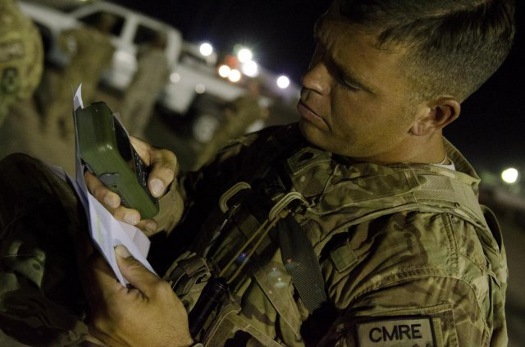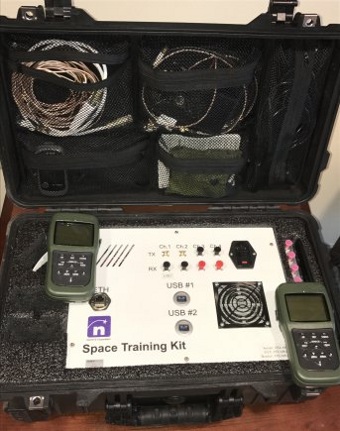 |
| December 05, 2017 | Volume 13 Issue 45 |
Designfax weekly eMagazine
Archives
Partners
Manufacturing Center
Product Spotlight
Modern Applications News
Metalworking Ideas For
Today's Job Shops
Tooling and Production
Strategies for large
metalworking plants
Army 'space kits' help Soldiers recognize jamming on comms devices and networks

Spc. Carl Arenberg, assigned to the 779th Engineer Company, prepares his Defense Advanced GPS Receiver (DAGR) for a night orienteering course. Using space training kits, small teams from U.S. Army Space and Missile Defense Command/Army Forces Strategic Command are now providing home station training to help Soldiers recognize when an enemy is interfering with their DAGR device or another piece of communications equipment. [Photo Credit: Sgt. Ryan Hallock]
By Sean Kimmons, U.S. Army, Ft. Meade, Maryland
A crash course on how to recognize jamming on communications devices and networks now helps prepare Soldiers for obstacles they may face while deployed or during rotations to combat training centers.
Using "space training kits," small teams from U.S. Army Space and Missile Defense Command/Army Forces Strategic Command travel around the Army to locations where home station training is conducted. The kits help Soldiers there learn how to identify when an enemy is interfering with their communications or navigation equipment.
"The biggest problem I'm seeing at the CTCs [Combat Training Centers], on a macro level, is that units aren't able to recognize that they are being GPS jammed," said Capt. Zeke Clayson, chief of CTC training for the command's G-3 Training Readiness Exercise Division. "They immediately assume it's an equipment issue or an operator issue."
Failure to realize that some electromagnetic interference may be an actual enemy attack can have major implications for a unit.
"I personally have seen that degrade an entire brigade's operations," Clayson said of scenarios at training centers. "These space kits enable the user at the lowest level to recognize when jamming is taking place and to prevent that sort of issue from arising."
Clayson's division typically works with two training kits. One of them, Space Kit 3, can replicate GPS jamming on handheld Defense Advanced GPS Receivers, also known as DAGRs. The Army provides DAGRs to Soldiers downrange to help them find their position and navigate while operating in unfamiliar locations.
In a classroom setting, instructors use Space Kit 3 to emit interference that Soldiers can then learn to detect using the DAGR's built-in analyzer.
After they recognize their devices are being jammed, Soldiers would then report the problem to the rest of their unit. Soldiers can also use the DAGRs to locate the source of the interference.
"Once they direction-find, then that provides the staff and commander the opportunity to either target that jammer or to report the situation to higher (command) and request that higher (command) resolve the issue," he said.
The newer Space Kit 4 can replicate enemy interference on satellite communications. While satellite communications receivers don't have an internal analyzer, he said, Soldiers can use an external spectrum analyzer to help identify interference.
"Based on the strength and frequencies they are seeing on the spectrum analyzer, they are able to determine whether that interference is deliberate or accidental," Clayson said.

Using space training kits, like the one pictured here, small teams from U.S. Army Space and Missile Defense Command/Army Forces Strategic Command provide home station training to help Soldiers recognize when an enemy is interfering with their communications equipment. [Photo Credit: Capt. Zeke Clayson]
With just one training kit, instructors are able to train more than 100 Soldiers a day. Soldiers need only about 20 minutes to get up to speed.
In that short time, trainers from SMDC are able to help Soldiers identify when their communications gear has been jammed. That skill has become increasingly important under the Army's multi-domain battle concept, which envisions dispersed forces operating in contested environments against near-peer threats.
"Right now, near-peers are very advanced in their space domain capabilities," Clayson said. "These space kits enable us to prevent them from overmatching us."
Soldiers more familiar on communications issues are already being seen at the National Training Center in Fort Irwin, CA, according to Maj. Steven W. Wojdakowski, space operations planner for the center's operations group.
"As we continue to replicate various forms of satcom denial each rotation, brigade combat teams are becoming more aware that the threat exists," he said. "Commanders place more emphasis on communications planning than ever before, but we still have much work to do."
Some brigades still struggle with exercising their full suite of equipment in response to fighting in a contested environment. Wojdakowski said that may in part be due to a lack of training on equipment such as the Secure Mobile Anti-Jam Reliable Tactical Terminal, the Spitfire satellite radio terminal, or the tactical satellite.
The Army has enjoyed assured access to the space domain for some time, Wojdakowski said, but going forward, threats to space-based assets must be considered as part of operational planning.
"Just as we fight for key terrain on the battlefield to enable maneuver, we should fight for so-called digital terrain to ensure connectivity by understanding the threat to our systems, targeting threat emitters and sensors, and reducing our footprints in the electromagnetic spectrum," he said.
The space kits are one way the Army can move in that direction by educating Soldiers on emerging threats.
"Soldiers appreciate the fact they are able to see what jamming looks like to them at their level and that they can do something about it to support the entire brigade's operations," Clayson said. "It empowers them."
Published December 2017
Rate this article
View our terms of use and privacy policy
